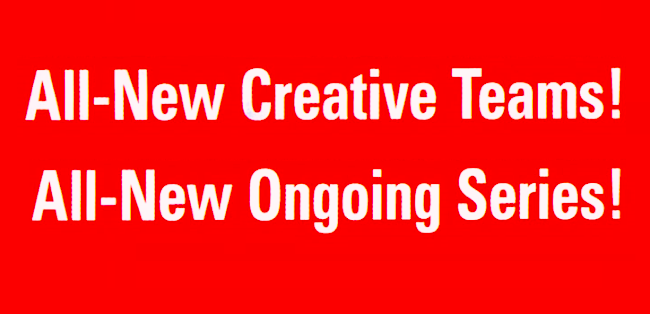“Transformaciones” es el título que le he dado a un grupo numeroso de publicaciones que he recopilado a lo largo de mi vida siendo aficionado a los comics, y que iremos compartiendo paulatinamente dentro de este blog. Algunas de ellas datan de décadas atrás y en los albores del Internet como plataforma de expresión escrita, incluyendo artículos de opinión, entrevistas y contribuciones esenciales en los años mozos de la “blogósfera”, repleta de voces con gran poder y con algo que decir acerca de este hobby que tanto nos apasiona. Todas ellas diseccionan al mundo de los comics desde diferentes aristas y matices. Algunos de ellos representan un retrovisor bastante interesante, y necesario para entender a su evolución como manifestación de las artes y plataforma multi-género. Sin mayor preámbulo, continuamos…
 El negocio del comic comercial norteamericano es uno bastante difícil. Una vez que las grandes editoriales lanzan su catálogo de ventas a las tiendas, las dejan a su suerte con la promoción de estos productos, y los propios autores han sido puestos a un costado en detrimento de sus carreras con el fin de promover a los trademarks usuales, a los bestsellers. Es triste ver cómo los autores sacrifican su paz mental (y muchas veces a su moral) al volverse parte de la maquinaria propagandística de las publicadoras más importantes, en lugar de tener un espacio y un micrófono para denunciar a los problemas fundamentales de un sistema fallido y que nos atañen a todos, y con ello corregir errores en beneficio mutuo.
El negocio del comic comercial norteamericano es uno bastante difícil. Una vez que las grandes editoriales lanzan su catálogo de ventas a las tiendas, las dejan a su suerte con la promoción de estos productos, y los propios autores han sido puestos a un costado en detrimento de sus carreras con el fin de promover a los trademarks usuales, a los bestsellers. Es triste ver cómo los autores sacrifican su paz mental (y muchas veces a su moral) al volverse parte de la maquinaria propagandística de las publicadoras más importantes, en lugar de tener un espacio y un micrófono para denunciar a los problemas fundamentales de un sistema fallido y que nos atañen a todos, y con ello corregir errores en beneficio mutuo.
Cuando los profesionales del medio comparten su opinión acerca de las realidades y problemas en el mundo del comic es un deleite; nos hace acercarnos más a ellos en lugar de construir una relación de antagonismo cuando comprometen a su integridad. A continuación, compartimos un artículo de opinión del escritor Jim Zub, quien ha podido labrar una carrera que se mueve entre la obra de autor y el mainstream con relativo éxito, y que nos habla de lo difícil que es competir dentro de una estructura que se preocupa únicamente por el beneficio económico a corto plazo, y negada a construir un acervo literario que sea sostenido, consistente y con potencial para trascender.
– – – – – – – – – –
Creator-Owned Economics: Grabbing The Long Tail
Por Jim Zub
Publicado originalmente en JimZub dot com el 16 de julio de 2016.
 The comic market is jam-packed with product. There are a cornucopia of choices for readers every week, with more titles fighting for dwindling shelf space and a sense that grabbing market share requires constant reboots, renumbering, and controversy in order to move the needle.
The comic market is jam-packed with product. There are a cornucopia of choices for readers every week, with more titles fighting for dwindling shelf space and a sense that grabbing market share requires constant reboots, renumbering, and controversy in order to move the needle.
Keeping a creator-owned title consistent and making it successful without the marketing muscle or global movie icon status Marvel or DC have is tough.
Wayward #11-15 follows what a lot of industry people would call ‘standard market attrition’. The start of each story arc sees a small boost and then the numbers continue to settle a bit lower each month after that. You’ll see a similar curve for a lot of superhero titles, which is why there’s a tendency to hit that ‘relaunch’ button more and more frequently. Raising awareness on a title and doing a round of press is expected for a new #1, while it’s much-much harder for readers, retailers, and reviewers to take notice of a #11 or a #16.
 In Wayward arc 3 we started skimming along the threshold where printing and distribution costs start to really eat into profitability. As I’ve talked about before, the cost of creating a product like a comic varies depending on your ‘price per unit’. The more you’re able to print (and sell), the cheaper each one costs, vastly improving your profitability. Once you dip below a certain key threshold, that balance between production cost and profitability starts to work against you.
In Wayward arc 3 we started skimming along the threshold where printing and distribution costs start to really eat into profitability. As I’ve talked about before, the cost of creating a product like a comic varies depending on your ‘price per unit’. The more you’re able to print (and sell), the cheaper each one costs, vastly improving your profitability. Once you dip below a certain key threshold, that balance between production cost and profitability starts to work against you.
The Long Tail: The importance of trade paperback collections for the long term viability of a series is undeniable and I think that trend is going to continue as the market continues to expand beyond traditional comic shops.
Digital Is Growth: As many people have noted, digital isn’t killing the traditional print market. Yes, there are people switching to digital, but the majority of digital comic readers seem to be “additive”, new or returning readers supporting work rather than pirating it.
 Single Issues Matter, But They’re Not The Whole Story: Single issue sales still have a place in this market. Serializing stories over months builds an audience, builds market awareness, and gives readers more options even if trade paperbacks are the go-to choice for more and more fans.
Single Issues Matter, But They’re Not The Whole Story: Single issue sales still have a place in this market. Serializing stories over months builds an audience, builds market awareness, and gives readers more options even if trade paperbacks are the go-to choice for more and more fans.
That said, I think the emphasis placed on single issue sales to determine success/failure is short-sighted and damaging.
The prose publishing world has slowly eaten away at the idea of “mid-list authors” and I think comics should be careful not to slip into a similar mindset. Comic sales continue to grow and the best way to keep those gains from being clawed back is by continuing to build out the market with variety rather than sinking all development into a narrow field of “hit-makers” or Hail Mary-style events/controversies/reboots/renumberings.


